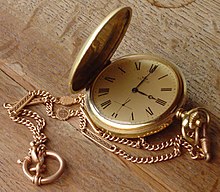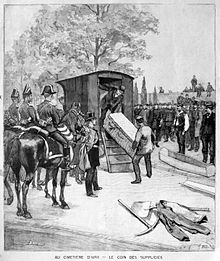Victor Prévost
That same evening, while Prévost helped his employer to put up fences over a small yard, he made it swing through a frame whose piece of glass plowed his hands and face.
Aware of his strength, Prévost never hesitated to help the many push carriages that had difficulties in climbing the steep slope of the Rue de la Montagne-Sainte-Geneviève.
One day, while running an errand for his boss, Prévost saw the cart of a milkman hit a boy of his age carrying a rack full of meat.
While the milkman ran away, Prévost helped the young victim get up and, finding that the boy was no longer in shape to resume his service, he loaded the heavy piece of meat on his head effortlessly and then delivered it to its recipient, a butcher holding a shop on Rue Mouffetard.
The task was tough, as the apprentices had to transfer heavy loads between Les Halles or private slaughterhouses and retailers, sometimes over long distances, but Prévost did not lack the strength.
[5] In the shop, he spoke Louchébem and behaved rather freely, with the cashier (a mistress of the boss) and one of the female servants quickly becoming attracted to the handsome apprentice.
Because of his experience with the cuirassiers, his good service and his height of 6 feet (at the time, the average size of men was about 5 foot 5 inches), he entered the very strict recruitment criteria[Note 2] of the prestigious cent-gardes Squadron that he joined on 20 January 1866, and was assigned the number 418.
[7] Consisting exclusively of large, experienced cavalry, the squadron of cent-gardes escorted the emperor Napoleon III on horseback in his public appearances, and assured his and his family's safety in the imperial palaces.
Their large size and their brilliant uniforms gave them very high prestige, and one of their peculiarities was to remain in all circumstances impeccably fixed, like statues, which earned them the nickname "caryatids of power".
Their immobility was legendary: the young Prince Imperial, still a child, mischievously emptied a box of dragees into the boot of a sentry on watch, who did not flinch.
[8][Note 3] Their unusual build, imposing appearance, and beautiful uniforms enamoured women, and many of them succumbed to the charm of the handsome horsemen: Many women came to admire each other on prom nights the glittering cuirasses; more than one noticed in the salons the frisky officers of the time, and God knows what we could tell about it if the heroes of many adventures were not yet alive, or their memory too respected by us, so that we were allowed to track their happy hours.
Madame Thiéry cautiously approached the place he abandoned and discovered, half stuck in a manhole, a packet containing freshly cut meat.
They immediately decided to take the package to the police station, but took the advice of a butcher and a pharmacist, who recognized fragments from a skinned human arm.
When asked to describe the suspect, she said that she did not know him, but using the light from a street lamp, she found that he bore a resemblance to the well-known peacekeeper in the neighbourhood, known under the soubriquet of "The Handsome Man".
This was another lie, as the day before, at around 21 o'clock, wearing a blouse and carrying a bucket covered with a cloth, he met a colleague to whom he said he was tired because he had just helped a friend move.
[18] On Sunday, 27 February 1876, she went to lunch at Prévost's house, who at the time lived at 22 Rue de l'Évangile, in front of the police station where he worked.
To put an end to an inquiry with uncertain results that promised to be long, while the authorities wanted to finish quickly, he was made to write a written statement in which he expressed his repentance for his two confirmed crimes.
[5] In his work concerning Prévost,[5] Gustave Massé talked about his discussions with Louis-Alphonse Hyrvoix, former chief of Napoleon III's cent-gardes who, as such, watched the guests at the balls, parties and receptions that took place at the Tuileries Palace.
At the Ball of Tuileries in 1867, Hyrvoix noticed a fair-skinned woman, dressed in a simple but tasteful manner, on the arm of an embassy attaché to whom she asked many questions, while taking notes in a small notebook.
This passion began to quickly affect his character, with Victor amusing himself by asking a passer-by for the time, just so he could see their shining gold watches, even if it was for a second.
[2] The day after his trial, on 9 December in the afternoon, Prévost was transferred to the La Roquette Grand Prison, a unique detention centre in which death row inmates were executed since 1851.
On the evening of the ceremony, he wrote a last letter to his brother Adolphe, in which he acknowledged his errors, expressed his desire for repentance and demanded "a thousand pardons".
It seems difficult to me now that he will suffer the same fate.The pardon was formally rejected on 18 January, and Louis Deibler, recently appointed chief executioner on 15 May 1was summoned to the prosecutor's office of the Republic and issued the ultimate requisition: Order is given to the chief executioner of criminal judgments to seize Victor Prévost, sentenced to death by the cour d'assises of Seine, on 8 December 1879, and proceed with his execution in public on Monday, 19 January 1880, at seven o'clock in the morning.
Warned that his execution would take place at 6:30, Prévost was asked to put on a white shirt, which he refused, and to keep his slippers on because the boots would hurt his feet.
For this first time, he was to be assisted by his first deputy designate, Alphonse-Léon Berger (later chief executioner of Corsica, 1870–1875), who was dismissed from Prévost's execution, which caused a lasting quarrel between the two men.
[24] Prévost's family did not claim his body, so he was put at the disposal of the dean of the Faculty of Forensic Medicine, for the purpose of an autopsy and phrenological studies.
[5][18] At half-past eight, only an hour and a half after his execution, Prévost's still-warm body was disposed of in Professor Charles-Philippe Robin's laboratory at the Practical School in the Faculty of Medicine in Paris.
[25] From his analysis, with assorted scholarly considerations, Prévost as put in the category of "smart murderers", but functional defects in the brain made it "very abnormal".
[26] From a very young age, Victor Prévost suffered from insatiable bulimia, inherited from his father, which manifested itself throughout his life: "I have a good appetite, I eat well; but do not gain weight.
During a banquet organized by the Friendly Association of the Ancient Cent-Gardes, Brigadier Valentin recounted having surprised Prévost, while he was stealing from the squadron's raw meat supplies.








